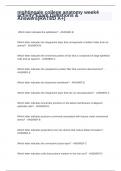Summary
Extensive Summary The Halloween indicator, sell in may and go away Another puzzle Sven Bouman Ben Jacobsen
- Course
- Institution
This is an extensive summary. In this summary you can find a sentence or two about each graph and figure based on the authors conclusion. I took just what was important to know about the article.
[Show more]












